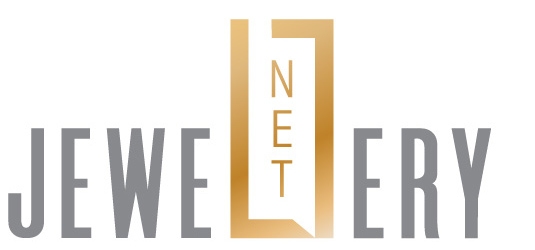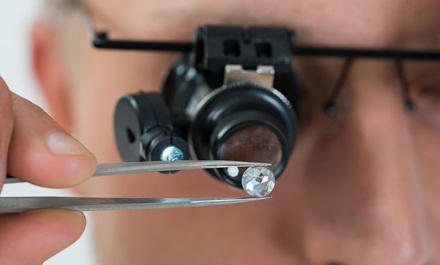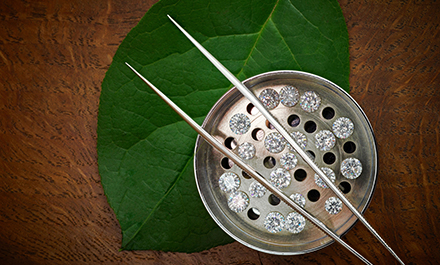Joanna Park-Tonks, president of the International Grown Diamond Association (IGDA), is pursuing an agenda of dialogue, transparency and creativity as she steers the category towards greater stability and growth.
This article first appeared in the JNA July/August 2023 issue.
Like many lab-grown diamond (LGD) players, Joanna Park-Tonks, president of the International Grown Diamond Association (IGDA), came to the LGD scene from a natural diamond background. She held senior positions at De Beers Group and market consultancy firm Accenture before founding lab-grown diamond jewellery brand Chelsea Rocks in 2018. In the beginning of 2023, she became president of IGDA where she focuses on the three R’s: Relationships, research and representation. In a frank discussion with JNA, she shares her insights on key issues impacting the lab-grown diamond trade.
JNA: What is driving demand for lab-grown diamonds?
Joanna Park-Tonks: Consumers are really taking the lead. Lab-grown diamonds are very appealing to younger people – the millennials and the Gen Zs – who are generally known for their intense online research. Consumers are often better educated and better informed than retailers on the subject. This groundswell of market acceptance will definitely continue. As long as our industry gives the consumers honest, fair and transparent information and provide full disclosure, we are on the right side of the law.
JNA: How should lab-grown diamonds be positioned and promoted in the market?
Park-Tonks: We need to sharpen our abilities and be creative in our storytelling. Our category has a fascinating story but there may have been too much focus on the technology and how they are produced. While that is important, let us not forget why people buy natural or lab-grown diamonds. These are the ultimate expression of love. As a category, we need to flow that creativity, love and passion into new designs. The slightly lower price points of lab-grown diamonds allow us to be more playful and experimental in design. Lab-grown diamonds should not be marketed as a commodity but as a special purchase linked to design, romance and artistry.
JNA: What aspects of the LGD trade need to be enhanced?
Park-Tonks: There is definitely room for improvement in our product and marketing. To me, cut is perhaps the most important of the 4Cs and is, from a technical perspective, an area we can enhance. We should also not forget the more poetic and artistic facets of lab-grown diamonds and promote this creation of manmade brilliance and ingenuity for the wonder that it is.
JNA: How is IGDA supporting the development of the lab-grown diamond market?
Park-Tonks: A key goal is providing the right information on lab-grown diamonds, especially at the retailer level. I am working on cue cards for retailers and IGDA members that would help them talk clearly about lab-grown diamonds with consumers in their stores. Ultimately, people buy what they are comfortable with. Disseminating real, useful information on lab-grown diamonds will help our category’s reputation. Omnichannel is the way forward and we need to work with retailers to promote consumer choice for lab-grown diamond purchases and provide them with the marketing assets and information needed so consumers can make solid decisions. Part of my work at IGDA is also working with different industry groups at a global level. I intend to put formal measures in place that will inform consumers of what they are buying. This entails promoting retailers and brands that sell certified goods but also possibly introducing a lab-grown diamond hallmark that can aid identification and disclosure.
JNA: How do you address accusations of greenwashing that are often levelled against the sector?
Park-Tonks: There is a lot of misinformation and disinformation written about sustainability and ecological benefits. Lab-grown diamonds are a product not of extractive mining but of manmade brilliance, ingenuity and
technological innovation. However, just because they are made in a lab does not necessarily make them sustainable.
We need to talk more honestly as a category about sustainability and be slightly wary and skeptical of relying only on carbon offsetting or third-party accreditation. Sustainability is a 360-degree picture – these conversations are not only about energy consumption per carat or the relative merits between growing techniques. We need to look at the ecological benefits and put people at the heart of the debate, looking at workers’ rights and the whole value chain within the industry. Sustainability is a journey, not a destination. Vivien Johnston Glass recently joined us at IGDA as Sustainability Chair to move this conversation forward properly.
JNA: Prices of lab-grown diamonds have been falling. How can the sector keep these at a respectable level?
Park-Tonks: The concept of Veblen goods in economics applies here – consumer perception of an item increases in value as its price increases. It is therefore critical that we maintain a very confident price point for lab-grown diamonds. I see that the industry is currently suffering from extreme price discounting, which is a terrible thing for a luxury product. We should halt this race to the bottom – selling purely on price would destroy the market. I wish we could stop this downward spiral of price and adopt a baseline. We can justify this confident price through high-end branding and storytelling, creativity and design, instead of just technology, product and price. It would be like Picasso selling his canvas or his paints rather than his art.
JNA: Analysts and industry players often cite impressive growth rates for the lab-grown diamond sector. What is your take on these projections?
Park-Tonks: There are a lot of statistics and projections being bandied around. As businesspeople, we feel comforted by facts and figures. But such figures are often not accurately referenced. More compelling than looking at charts, statistics and graphs is understanding the power of collective voice. The possibilities are endless if we work together diligently to prevent challenges like ever-decreasing prices and value erosion. The statistics that have been presented on the lab-grown diamond market have to be viewed in the proper perspective. It is the industry that has the power to make a difference. We will be releasing properly referenced figures in due time.
JNA: What role do you want IGDA to play in the LGD space?
Park-Tonks: One of my priorities at IGDA is to create a platform to come together as an industry. We are going through a period of consolidation. There will potentially be fewer players in the future and we need to monitor how the price crunch develops. But we are stronger together and must come together to speak as one sector and really push our category forward. There is a lot of good work we can do together.










